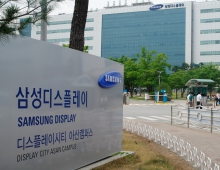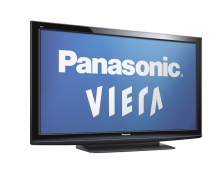
TV price war heats up
Though prices for smaller flat-screen displays could rise this year, big-screen TV prices are set for a prolonged slide as a battle rages between liquid crystal and plasma display standards. Sacrificing profit for market share?
Manufacturers of large sets over 40 inches using either liquid crystal (LCD) and plasma (PDP) technology are spending aggressively on technology to make cheaper sets and draw consumers away from boxy, smaller cathode-ray TVs.
Consumer tech giants such as Sony and LG Electronics are sacrificing profit for market share, analysts say.
"Above all, price will be the most important factor when it comes to who will win the battle between plasma and LCD for big flat-screen TVs," said UFJ Tsubasa Securities analyst Kazuya Yamamoto.
"Most consumers are not happy about forking out upwards of 500,000 yen ($4,640) for a TV, no matter if it's LCD or plasma. So the question is which side can lower costs the fastest to spur on and capture demand."
Over the past year, prices of both have fallen sharply.
A 42-inch plasma TV set using high-definition technology, which is widely expected to emerge as a global broadcast standard, currently sells for around $4,000, while the same size LCD costs about $5,000, according to Samsung Electronics and LG. A less hi-tech 42 inch plasma set can be bought for $2,000.
"LCD makers will need to add new generation lines faster than originally planned to meet the aggressive plasma pricing," Lehman Brothers said.
Cathode-ray sets account for more than 90 percent of global TV sales. As smaller LCD sets get cheaper that share will fall to 81 percent next year, Lehman Brothers said. But it has been a costly battle for makers.
LCD prices dropped nearly a third last year and are still more than double the price of comparable cathode-ray sets.
Analysts say the price of a 32 inch LCD set should drop another 40 percent to around $1,430 to grab more customers.
In the race for profitability, LCD makers say prices for some flat screen sets -- particularly 17-inch models, which can be bought for a few hundred dollars -- are set to recover in the second half of this year.
LCDs last longer than plasma screens but are not as bright, while energy-hungry plasma screens have a wider viewing angle but can require noisy fans to keep them cool.
In the medium term, plasma appears to have the edge in prices for big-screen TVs but huge LCD investment plans could change the picture.
"As LCD prices come down, they will manage to beat out plasma in the 40-inch area in 2007 and 2008. We will see a cut-throat price war between the two competing technologies next year," said Michael Min, a tech analyst at Dongwon Securities in Seoul.
"The key is how much PDP makers can cut their price to compete with free-falling LCDs."
DisplaySearch, a research group, says that by 2008, plasma will account for 73 percent of the global market for 40-inch or larger flat TVs.
LG Electronics, Samsung SDI, Panasonic products maker Matsushita Electric Industrial and Pioneer Corp. are betting on plasma technology.
"We expect production costs to drop by some 20 percent with the introduction of a new technology called 'single scanning' that halves the number of driver chips required to display images on the screen," said G.W. Kim, a spokesman at LG Electronics.
Pioneer said it would raise efficiency by consolidating different panel sizes into three from six.
Asian LCD makers plan to invest more than $51 billion in production over the next decade, which could lower costs dramatically.
"Nearly all of Taiwan's major display makers focus on LCDs as they think the future mainstream TV products will be below 40 inch," said Ben Lee, head of Nomura International's equity research in Taiwan.
LG.Philips LCD, the world's No.2 LCD maker, unveiled a $5.3 billion plan in November to build an advanced factory line for mass production in the first half of 2006.
Bigger rival Samsung Electronics just started volume production of high-end panels at its joint venture with Sony, while Sharp Corp. plans to invest 160 billion yen to open a new plant in 2006.
Taiwan rivals AU Optronics and Chi Mei Optoelectronics also have new factories planned.
Consumer tech giants such as Sony and LG Electronics are sacrificing profit for market share, analysts say.
"Above all, price will be the most important factor when it comes to who will win the battle between plasma and LCD for big flat-screen TVs," said UFJ Tsubasa Securities analyst Kazuya Yamamoto.
"Most consumers are not happy about forking out upwards of 500,000 yen ($4,640) for a TV, no matter if it's LCD or plasma. So the question is which side can lower costs the fastest to spur on and capture demand."
Over the past year, prices of both have fallen sharply.
A 42-inch plasma TV set using high-definition technology, which is widely expected to emerge as a global broadcast standard, currently sells for around $4,000, while the same size LCD costs about $5,000, according to Samsung Electronics and LG. A less hi-tech 42 inch plasma set can be bought for $2,000.
"LCD makers will need to add new generation lines faster than originally planned to meet the aggressive plasma pricing," Lehman Brothers said.
Cathode-ray sets account for more than 90 percent of global TV sales. As smaller LCD sets get cheaper that share will fall to 81 percent next year, Lehman Brothers said. But it has been a costly battle for makers.
LCD prices dropped nearly a third last year and are still more than double the price of comparable cathode-ray sets.
Analysts say the price of a 32 inch LCD set should drop another 40 percent to around $1,430 to grab more customers.
In the race for profitability, LCD makers say prices for some flat screen sets -- particularly 17-inch models, which can be bought for a few hundred dollars -- are set to recover in the second half of this year.
LCDs last longer than plasma screens but are not as bright, while energy-hungry plasma screens have a wider viewing angle but can require noisy fans to keep them cool.
In the medium term, plasma appears to have the edge in prices for big-screen TVs but huge LCD investment plans could change the picture.
"As LCD prices come down, they will manage to beat out plasma in the 40-inch area in 2007 and 2008. We will see a cut-throat price war between the two competing technologies next year," said Michael Min, a tech analyst at Dongwon Securities in Seoul.
"The key is how much PDP makers can cut their price to compete with free-falling LCDs."
DisplaySearch, a research group, says that by 2008, plasma will account for 73 percent of the global market for 40-inch or larger flat TVs.
LG Electronics, Samsung SDI, Panasonic products maker Matsushita Electric Industrial and Pioneer Corp. are betting on plasma technology.
"We expect production costs to drop by some 20 percent with the introduction of a new technology called 'single scanning' that halves the number of driver chips required to display images on the screen," said G.W. Kim, a spokesman at LG Electronics.
Pioneer said it would raise efficiency by consolidating different panel sizes into three from six.
Asian LCD makers plan to invest more than $51 billion in production over the next decade, which could lower costs dramatically.
"Nearly all of Taiwan's major display makers focus on LCDs as they think the future mainstream TV products will be below 40 inch," said Ben Lee, head of Nomura International's equity research in Taiwan.
LG.Philips LCD, the world's No.2 LCD maker, unveiled a $5.3 billion plan in November to build an advanced factory line for mass production in the first half of 2006.
Bigger rival Samsung Electronics just started volume production of high-end panels at its joint venture with Sony, while Sharp Corp. plans to invest 160 billion yen to open a new plant in 2006.
Taiwan rivals AU Optronics and Chi Mei Optoelectronics also have new factories planned.





















